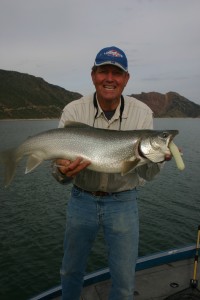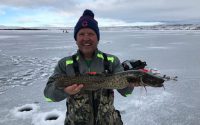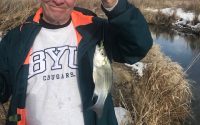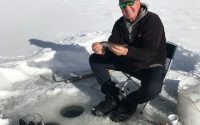Shifting Gears For Fall Fishing
 Living in Utah brings many changes to the fishing environment. Not only do the seasons change but since most of our lakes and streams are meant for water storage, water levels are very quick to rise and drop. And, adding to the equation, fast-moving storms frequent our state year-round.
Living in Utah brings many changes to the fishing environment. Not only do the seasons change but since most of our lakes and streams are meant for water storage, water levels are very quick to rise and drop. And, adding to the equation, fast-moving storms frequent our state year-round.
Fall is an incredible time to be fishing in the Beehive State. Since hunting is also a huge sport, many of the would-be anglers are off hunting from August 15th through the end of October, so those who don’t hunt but love to fish have the lakes and streams to themselves. I happen to enjoy hunting though I am certainly more passionate about fishing. It is about the changes in my behavior as the cold fall winds begin to blow that moves me to write this post.
During six months of the year, I fish for bass at least one to two days a week. Add to that, the occasional trout fishing trip or even a tiger muskie, walleye, or even catfish trip into the mix and you can see I spend a lot of time on the water. But, in Utah, because within the month of October most of the bass waters will (with the exception of a handful of reservoirs including Lake Powell) will see their surface temperatures fall to under 50 degrees, except for very deep or (after a couple of warm days) very shallow bites, most of the bass will slow down and move into much deeper water to begin the long winter period.
Rather than slow down with the bass, I choose to change gears and start to chase giant lake trout in Flaming Gorge. From right now until the end of November, the lake trout spawn. This is a time that several species of fish gather in close proximity to one another and feast on eggs. The most amazing thing I witnessed a couple of years back was that I caught three species of fish (lake trout, rainbow, and burbot) within minutes of each other and all three were stuffed to the gills with lake trout eggs. So, it’s not just the rainbows and burbot that eat eggs, so do the juvenile lake trout.
Let’s take a look at how to target lake trout before, during, and after the spawn. First, you must know I am only writing about Flaming Gorge Reservoir, though I’m sure things I will say might have application on other lakes. On the Gorge, the lake trout try to find gravel humps and points on which to lay their eggs. In the Linwood Bay area there are several humps of gravel left over from an old quarry that was flooded when they filled the reservoir. The fish move on and off of these humps as they prepare to spawn.
This is the time that true “jigging” works very well to entice the lake trout to bite. During other times of the year I keep my tube very still and don’t actually use the standard jigging motion (sharply up and then let it fall back). Buzz Bombs in chartreuse and white are the most popular lures on the lake, but I still enjoy using 3 1/2 to 6-inch Gitzits in white, green, and black.
The spawning humps are found in 50 to 75 feet of water and the fish move in and out, up and down depending on a couple of things: time of day, and light conditions. Lake trout spawn at night mainly and so they are much more active in low light conditions. Regulations dictate that there is to be no fishing after sundown or before sunrise, so there are specific windows of time when you must be on the water. Usually the fish will be active until 9 a.m. and then from around 3 p.m to sundown. However, if it is a cloudy or overcast day, the fish may remain active for longer periods of time.
I always use Canyon Plastics Gitzits and I recommend them to anyone. Garlic is my favorite mask or attractant and I try and find the most potent of the brands out there. I really like “Bang” when I can find it.
Another trick I use is to find rocky points close to the spawning areas and toss Pointer minnows (128s) right into the rocks. I sometimes catch a huge rainbow, or maybe a 3-plus bound smallmouth bass, but at times, I’ll get into a 7 to 10-pound school of lake trout that simply won’t leave the bait alone.
Yes, fall is the time I change gears, leave the bass for a couple of months and concentrate on lake trout. It’s a great change of pace, and it prepares me for the great bassin’ I’ll be doing in a few short months.










